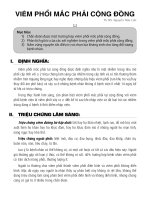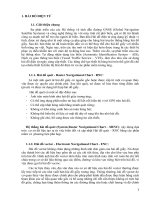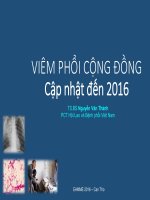Bài giảng cập nhật quản lý hen, copd ts bs nguyễn văn thành
Bạn đang xem bản rút gọn của tài liệu. Xem và tải ngay bản đầy đủ của tài liệu tại đây (3.55 MB, 38 trang )
CẬP NHẬT QUẢN LÝ
HEN, COPD
TS.BS NGUYỄN VĂN THÀNH
Hội nghị khoa học toàn quốc lần thứ 7, Hà Nội 30/6/2017
Bản chất bệnh học: HEN, COPD
Viêm mạn tính
Chịu sự tác động của cả yếu tố môi trường lẫn yếu tố cơ
địa
Biểu hiện đa dạng (heterogeneous)
Có thể chồng lấp (overlapse) giữa hai bệnh
HEN: VIÊM ĐƯỜNG THỞ (AIRWAY INFLAMMATION)
Cơn cấp tính
COPD: VIÊM ƯU THẾ Th2 và BCAT
QUẢN LÝ HEN
- Phân biệt giữa khái niệm mức độ nặng và mức độ
kiểm soát
- Khái niệm Hen nặng kháng trị (severe refractory
asthma)
- Phenotype hen
- Thực hành chẩn đoán và Phân bậc năng lực quản lý
- Vai trò kháng muscarinic receptor
- Tiếp cận quản lý Hen nặng kháng trị
MỨC ĐỘ KIỂM SOÁT VÀ MỨC ĐỘ NẶNG
’’Asthma control’’ refers to the extent to which the manifestations of asthma
have been reduced or removed by treatment. Its assessment should
incorporate
components
current
(e.g. symptoms,
’’Kiểm soát the
hen''dual
là mức
độ cácofbiểu
hiệnclinical
bệnhcontrol
giảm hoặc
mất dưới
reliever
andgiálung
function)
and
riskthành
(e.g. phần
exacerbations
điều trị.use
Đánh
kiểm
sốt nên
kếtfuture
hợp các
lâm sàngand
hiệnlung
tại
function
decline).
(ví dụ: triệu
chứng, sử dụng thuốc và chức năng phổi) và nguy cơ tương lai
(ví dụ như đợt cấp, suy giảm chức năng phổi).
The most clinically useful concept of asthma severity is based on the
intensity
treatment
required
to về
achieve
good
control,
i.e. điều
severity
Khái
niệmoflâm
sàng hữu
ích nhất
mức độ
henasthma
dựa trên
mức độ
trị
is assessed
Severe
asthmalà ismức
defined
as the requirement
cần
để đạtduring
được treatment.
kiểm soát
tốt, nghĩa
độ nghiêm
trọng được
for highintensity
treatment.
đánh
giá trong quá
trình điều trị. Bệnh hen nặng được định nghĩa là yêu
cầu điều trị cường độ cao.
Eur Respir J 2008; 32: 545–554 (20)
HEN NẶNG KHÁNG TRỊ (SRA)
Hen nặng
(cần điều trị với mức độ cao)
Kiểm sốt
khơng tốt
Kiểm sốt tốt
Có thể kiểm
sốt tốt nhưng
khơng tn thủ
Có bệnh đồng
mắc khơng
kiểm sốt
Hen khơng đáp
ứng điều trị
Eur Respir J 2008; 32: 545–554 (20)
Hen hay Hen - Phenotype
Investigational biologic may reduce need for
systemic corticosteroids in patients with severe
asthma (ATS conference 2017- on line)
BTS Revised 2016
CHẨN ĐOÁN
GINA 2017 –
VAI TRÒ KIỂM TRA ĐÁNH GIÁ THƯỜNG XUYÊN
70-80% sử dụng dụng cụ hít khơng đúng cách
Hen là bệnh biểu
hiện đa dạng
Thay đổi chế độ điều trị
dựa trên đánh giá mức độ
kiểm sốt và tính phù hợp
Hen và hút thuốc lá
The prevalence of active smoking in adults
with asthma is similar to the general
population. Smoking asthma is associated
with poorer disease control, impaired
response to corticosteroid therapy,
accelerated decline in lung function, and
increased rate of healthcare utilization.
Current asthma guidelines do not provide
specific treatment advice for smoking
asthmatic patients. There is an urgent need
for better understanding of the underlying
mechanisms and effective treatment for
smoking asthmatic patients
Chatkin and Dullius. Asthma Research and Practice (2016) (26)
UK 2016 – ĐIỀU TRỊ – NGƯỜI LỚN
LAMA, LTRA,
THEO SR, MCL...
ICS
ICS-LABA
OCS
UK 2016 – ĐIỀU TRỊ – TRẺ EM <12 tuổi
ICS, LTRA
ICS-LABA
OCS
GINA 2017
1. Kế hoạch điều trị thiết kế cụ thể cho từng người bệnh, Cần nhắc lại thông tin
quan trọng và kiểm tra sử dụng thuốc
2. Mở rộng chỉ định liều thấp ICS
3. Điều trị nền tảng Step 3-4 là ICS/LABA
4. Xuống bậc sau 2-3 tháng kiển soát tốt (nếu khơng có nguy cơ vào đợt cấp).
Khơng nên ngưng ICS
5. Lên bậc bằng ICS/LABA (trẻ em 6-11 nên tăng liều ICS)
6. Tiotropium kết hợp (>12 tuổi) cho bn nhiều đợt cấp.
Ach và vai trò LAMA
Ach làm tăng viêm trên đường thở và giảm
đáp ứng AR (cross talk)
(13)
Tiếp cận theo cách xác định bản chất viêm-dị ứng
(Hội Phổi – Dị ứng Szech 2017)
GINA-approach: “blanket” stepwise pharmacologic treatment strategy
Allergy 5/2017
ĐỀ XUẤT TRONG THỰC HÀNH VIỆT NAM
Những trở ngại thực hành nhìn từ GOLD
guideline 2017
Masaharu Nishimura. Respirology (2017) 22, 621
- There were some important limitations and/or concerns leading to some
criticism and a measure of confusion has ensued in some respiratory
CHẨN ĐOÁN communities.
VÀ ĐÁNH GIÁThis is because the ABCD assessment tool was introduced
without any clear evidence based on clinical data. For instance, the ABCD
assessment tool performed no better than spirometry grades or the BODE
index for mortality prediction or other important health outcomes.
- These treatment algorithms may cause some confusion. Future
PHÂN LOẠI PHENOTYPE
evelopments of the GOLD guidelines should help provide clarification and a
movement towards more evidence-based personalized medicine approaches.
- There may be potential differences in COPD phenotypes, which may exist
TÁC ĐỘNG TỪbased
THỰCupon
TẾ VIỆT
(NGƯỜI
HỆ THỐNGsystem
Y TẾ VÀ
XÃ HỘI)
race,NAM
region,
cultureBỆNH,
and healthcare
and/or
access to
medical care. For instance, even in individuals who have a similar level of
airflow limitation, physical characteristics, symptoms, exacerbation frequency,
co-morbidities and even cause of death can be very different









